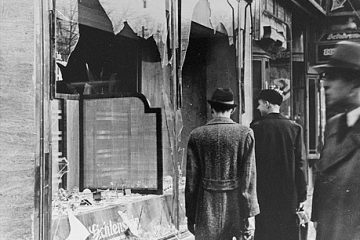Expressions of remembrance

Yom Hashoah Observance brings generations together to reinforce the Holocaust’s lessons
By Marshall Weiss, The Dayton Jewish Observer
Sam Heider was the only one out of his family of nine to survive the Holocaust. He made it through Auschwitz and Dachau. Heider met his wife, Phyllis, who survived Bergen-Belsen, in a DP camp in 1945. In 1949 they and their 21/2-year-old son arrived by train to settle in Dayton, their new home.
In the early 1950s, Heider and other survivors who settled here held their first Holocaust commemoration, at Beth Abraham Synagogue. Each year after, they would come together to cry and remember. In 1964 this would become the Greater Dayton Yom Hashoah Observance.

After the Heiders retired to Florida, they would return to Dayton to visit family and friends at the High Holy Days and from Passover through Yom Hashoah.
At each year’s observance, when his health permits, Heider chants El Maley Rachamim — a prayer for the peace of the departed soul — in memory of those who perished in the Holocaust.
On April 4, a week and a half before Passover, Heider’s wife of 69 years died.
Three weeks later, in front of Beth Jacob’s full sanctuary of Jews and non-Jews, middle and high school students who won prizes in the Holocaust writing and art contests and their parents — and buoyed by the presence of members of the Israel Defense Forces — Heider recited El Maley Rachamim at this year’s Yom Hashoah Observance.
“As long as we have the IDF, the Israel Defense Forces, with some of them here tonight, to defend Israel at any time, and as long as the gates to Israel are open, the doors to the crematoriums are going to be closed forever,” he said before reciting the prayer.
Five Israeli soldiers participated in the April 27 observance in conjunction with Partnership2Gether, a program of the Jewish Federation, the Jewish Agency for Israel, and Israel’s Western Galilee region.
During the ceremony, they talked about how the Holocaust inspires their service to the Jewish state.
Ari Rosenstein, a 26-year-old intelligence officer from Beit Shemesh, told of an IDF ceremony he took part in at Auschwitz.
“As I stood at attention, the sound of the Israeli national anthem, and when the shofar sounded, my eyes were filled with tears,” the

Brooklyn-born grandson of Holocaust survivors said. “At that moment, I was shattered to the core. But suddenly I realized: I remembered I was not alone. We are not alone. The Jews are not alone. The state of Israel is reborn from the ashes of the Holocaust. And it’s here to stay. It represents the Jewish triumph of life over death, and it’s here to stay. We’ll make sure of that. With God’s help, the IDF will make sure of that.”
Second Lt. Shir Hoshkover, 20, is an education officer with the IDF Education and Youth Corps.
“The education in the army is the education for values,” she said. “One of the biggest goals of the education corps in the army is to make the soldier a better person and a better citizen for later in life.”
Hoshkover is a guide for commanders touring Yad Vashem.
“One of the most important lessons that you can learn from the Holocaust is the fact that the people who did it — the Nazis — they were just people like me,” she said. “They weren’t monsters or aliens, they were people. They had families and were great fathers or grandfathers at home. But outside they lacked the values and the moral standards that each of us needs to have to make the world a better place. You don’t have to be a Jew to relate to that. Many commanders that I train are not Jewish.”
Hoshkover said that when she was a little girl, her mother told her when she grew up she wouldn’t need to go into the army because there would be peace.

“Well, I probably will say it to my kids one day,” she said. “But here I am in front of you, an officer of the IDF, so proud to be here and to say the Jewish people lives. Am Yisrael Chai.”
Just before Heider chanted El Maley Rachamim, he said, “And to the six million Jewish brothers and sisters — including one and a half million Jewish children who perished during the Holocaust — let us say just two words, Never Again. They will hear our voices and they will sleep in peace.”
After he intoned the prayer, Heider descended the steps from the bima. The program came to a halt. The audience remained on its feet. In silence, Heider walked to the soldiers. Tears streamed down their faces when they embraced him.
To read the complete June 2014 Dayton Jewish Observer, click here.





